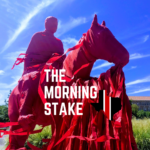Stuff
 Thank you all so much for the coffees. Your appreciation for what I do here is greatly appreciated on my end. Today’s stories are a handful of links that have hit the news the last day or two that affect
Thank you all so much for the coffees. Your appreciation for what I do here is greatly appreciated on my end. Today’s stories are a handful of links that have hit the news the last day or two that affect
Big 12 Stuff
 CBS Sports’ Dennis Dodds wrote today that the Big Ten is close to a media rights deal worth up to $1 billion PER SEASON. That’s correct. $1 billion.
CBS Sports’ Dennis Dodds wrote today that the Big Ten is close to a media rights deal worth up to $1 billion PER SEASON. That’s correct. $1 billion.
The main issue at hand for the Big Ten, according to industry sources, is deciding whether to give Fox all its rights, split those rights as they presently do with ESPN, or take a different road: find a partner besides ESPN or attempt to expand even further.
Warren stressed the presence of seven suitors in negotiations: CBS, NBC, TNT, Apple and Amazon in addition to Fox and ESPN. He would not say whether the league favored one, two or multiple partners as it considers its options.
As you might expect, this dwarfs what The Big 12 would be paying out and the SEC is out-pacing the $1 billion figure right now. Of course the Big 12 will be renegotiating in 2024-25 I think, so who knows what might happen.
Will the Power 5 soon become the Power 2?
Unpacking the impact of the new media rights deal for the SEC and an estimated monster payout for the Big Ten … and everybody else: https://t.co/j6pfNdD9Gd pic.twitter.com/XTwb5rwMJ2
— Nicole Auerbach (@NicoleAuerbach) May 3, 2022
 Action Network’s Brett McMurphy is reporting that Cincinnati, Houston, and UCF are negotiating a settlement to get out of the American Athletic Conference and would become members of the Big 12 in July of 2023.
Action Network’s Brett McMurphy is reporting that Cincinnati, Houston, and UCF are negotiating a settlement to get out of the American Athletic Conference and would become members of the Big 12 in July of 2023.
Cincinnati, Houston and UCF are negotiating a settlement in the “$17 million to $20 million range,” which would allow the schools to exit the American Athletic Conference early and officially join the Big 12 on July 1, 2023, sources told Action Network.
The completion of that deal would then allow the six Conference USA schools — Charlotte, FAU, North Texas, Rice, UAB and UTSA — to join the AAC on July 1, 2023.
AAC by-laws require departing schools to provide 27 months’ notice and pay a $10 million exit fee. Without the settlement, the schools may not leave until July 1, 2024.
BYU, an independent, will officially join the Big 12 next season.
Remember that Oklahoma and Texas will be members of the Big 12 until 2025, unless they negotiate an early exit fee themselves.
 CBS Sports’ Dennis Dodds is also reporting that the Big 12’s idea to split into divisions for the 2023-24 season is put on hold:
CBS Sports’ Dennis Dodds is also reporting that the Big 12’s idea to split into divisions for the 2023-24 season is put on hold:
A special Big 12 subcommittee formed to determine how to best incorporate up to 14 teams in conference realignment from 2023-24 had been expected to finalize league composition and schedules this week. However, the Big 12 is awaiting resolution on a proposal from the NCAA Football Oversight Committee that would allow all leagues to play without divisions but still hold conference championship games without a waiver from the association.
That would give conferences an opportunity to match their two best (usually highest-ranked) teams in league title games. The legislation would be an option, not a mandate. Currently, the only FBS conferences that play without divisions are the 10-team Big 12 and 11-team American. The Big 12 plays a round-robin schedule, granting it the ability to play a conference championship game, while the AAC has an NCAA waiver to match its two best teams for the league title.
With divisions becoming less of a consideration, the Big 12 has to retrench with its largest membership ever, albeit temporarily.
The full-scale cutting of the signing cap isn’t the only concept on the table, officials say. Maybe the 25-plus-7 (32) plan will be extended. Or maybe a “one-for-one” plan is instituted, allowing coaches to replace each transferring player with no limit.
“We have to do something,” says Neal Brown, the West Virginia coach who serves on the American Football Coaches Association board of directors. “The current system doesn’t work. It’s extremely difficult to get to your 85 without putting walk-ons on scholarship.”
For those of you who are concerned about the wild times and non-stop transfers, Dellenger is also reporting that there would be portal signing periods, which sounds better for me as a blogger who feels like he constantly has his head on a swivel regarding the portal:
The portal would open for a 4-week period starting the Sunday after the last regular season game & close 5 days after a team’s bowl. It would open again for a 2-week period starting April 15 & then close May 1.
Eliminating the signing limit has more hurdles to go still.
 Dellenger is also, also reporting that there could likely be restrictions on the NIL that’s gone a bit insane over the past year.
Dellenger is also, also reporting that there could likely be restrictions on the NIL that’s gone a bit insane over the past year.
University administrators, part of a task force to review NIL, are finalizing additional guidelines that are expected to clarify that boosters and booster-led collectives are prohibited from involvement in recruiting, multiple sources tell Sports Illustrated. The guidelines will provide more guidance to member schools on what many administrators say are NIL-disguised “pay for play” deals orchestrated by donors to induce prospects, recruit players off other college teams and retain their own athletes.
The new directives will highlight existing NCAA bylaws that outlaw boosters from participating in recruiting, reminding member schools of guardrails that, while in place for years, have been bent and broken during the first 10 months of the NIL era, officials say. Under a long-held NCAA rule, boosters are a representative arm of an athletic department and are not supposed to associate with or persuade prospects.
The guidelines, still in draft form, outline that booster-backed collectives should be prohibited from associating with high school prospects and college transfers, potentially opening the door for contentious legal challenges between the association and booster groups.
Schools that do not control their donors’ spending could be found to have violated NCAA rules and will be sanctioned, according to the document. The NCAA enforcement staff have made inquiries only into a small handful of programs so far, but the guidelines could spark deeper investigations into improper inducements tied to NIL payments.
Enforcing this is going to be incredibly tough, but the NCAA had years to try to figure out a framework and some rules and when the courts ruled against them they had their pants around their ankles and were completely unprepared. Now all hell has broken loose.









